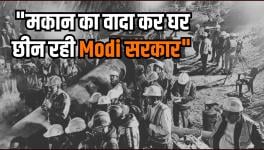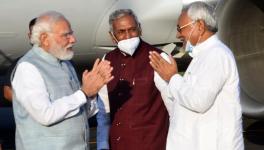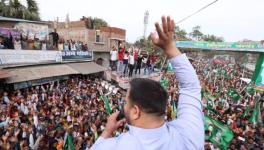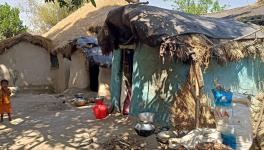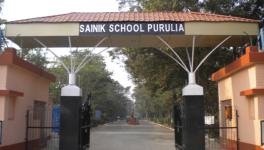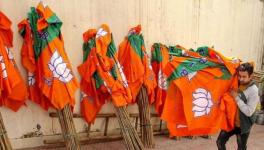Bihar: BJP Stoking Hindutva Politics Ahead of Amit Shah's Seemanchal Visit
Union Home Minister Amit Shah. Image Courtesy: PTI
Patna: Ahead of the much-publicised visit of Union Minister Amit Shah to Seemanchal, a Muslim-dominated backward region of Bihar, the Bharatiya Janata Party has been playing its well-tested Hindutva card. The party is trying to polarise the poverty-stricken people and target the Mahagathbandhan (RJD, JD-U, Congress and Left parties) government led by Chief Minister Nitish Kumar.
In a bid to galvanise support for Shah’s visit, the BJP is not missing any chance to play its Hindutva politics. Senior BJP leaders, including Union Minister Giriraj Singh, state party president Sanjay Jaiswal, and a few party MLAs have been voicing controversial issues like alleged infiltration by Bangladeshi and Rohangiyas in Seemanchal, cow slaughter, increasing population of Muslims and decreasing population of Hindus. These claims are reportedly being spread to create fear, target Muslims and polarise Hindus.
Shah will meet party leaders and workers and address public meetings during his two-day visit to Seemanchal on September 23-24. This will be the first visit of any top BJP leaders to Bihar after the party was ousted from power and is yet to overcome the big jolt.
Shah, known as a master strategist of the Hindutva agenda, has specifically chosen Seemanchal for his visit to virtually launch a campaign for the 2024 Lok Sabha polls. Seemanchal is considered a stronghold of the Mahagathbandhan and a politically weak area for the BJP in Bihar.
According to reports in local Hindi dailies, 14 teams of BJP leaders and workers have been working on the ground in Seemanchal to make Shah’s visit a big success. Besides, workers of the Rashtriya Swayamsevak Sangh -- the mentor of BJP and other Hindu organisations like the Vishwa Hindu Parishad, Bajrang Dal, and ABVP -- have been deployed in large numbers to mobilise people for the upcoming visit.
Giriraj Singh, the BJP MP from Begusarai parliamentary constituency and a vocal champion of the party’s Hindutva politics, Union Minister Nityanand Rai, Jaiswal and dozens of MPs, MLAs and former ministers have been regularly visiting and camping in Seemanchal preceding Shah’s visit.
On Tuesday, Singh, who is in charge of the party programme of Shah’s visit, expressed serious concerns over the purportedly increasing Muslim population in Seemanchal. He blamed the “appeasement policy” of the Bihar government for the supposedly decreasing population of Hindus. Speaking in Purnea, Singh said it is part of a conspiracy to turn India into “Ghazwa e Hind” and “infiltrators have been protected by some with vested interest for political benefit.”
Singh further claimed that Seemanchal has become a hub of cow slaughter due to the government’s appeasement policy.
Earlier this month, Singh demanded a survey of madrasas and mosques in Bihar, particularly in Seemanchal, similar to what has been done in Uttar Pradesh.
In the first week of September, Jaiswal claimed that the Muslim population was rapidly increasing in two districts of Araria and Kishanganj in Seemanchal because it has the highest birth rate in the country.
It is a different matter that the ruling JD-U countered by saying that Jaiswal was giving wrong and misleading information and the population growth rate in several other districts in India is much higher than Araria and Kishanganj. JD-U spokesperson Neeraj Kumar then said that Jaiswal was trying to incite communal hatred among people.
Jaiswal was supported by saffron-clad BJP MLA Hari Bhushan Thakur, who has emerged as a firebrand Hindutva icon in the state. Thakur has even dared Chief Minister Nitish Kumar to explain how the Muslim population is increasing in Seemanchal.
BJP leaders have been directly attacking Kumar in the recent weeks after he dumped the saffron party and joined hands with the Mahagathbandhan last month to form a new government in the state. Since then, the BJP has repeatedly claimed that ‘jungle raj’ has returned to Bihar.
BJP’s actions can be seen in the context of Kumar’s party, Janata Dal-United, projecting him as the prime ministerial candidate of the ‘united opposition' in the 2024 Lok Sabha elections against PM Narendra Modi.
JD-U national president Rajiv Ranjan alias Lalan Singh on Tuesday announced that his party will stage a statewide protest on September 27 against the central government led by PM Modi. “Our party leaders and workers at all block headquarters to district headquarters will stage protest against Modi government and its policies that resulted in unprecedented price rise, joblessness and threat to communal harmony,” he said.
The JD-U leader has made it clear that the state government will not allow anyone to disturb communal harmony in Bihar and urged people to counter those who try to do so.
There is nothing new in the BJP’s approach to Seemanchal. BJP, RSS, VHP and Bajrang Dal have been targeting Muslims in Seemanchal in the name of “illegal settlers”, cow slaughter and cattle smuggling for years.
Amid protests against the CAA- NRC in 2019, BJP Rajya Sabha MP Rakesh Sinha, who is also considered close to the RSS, had then said that the party strongly favoured NRC in the Seemanchal region of Bihar. NRC should be implemented there, like in Assam, to flush out all those from Bangladesh who settled there.
Sinha, a vocal champion of the BJP’s Hindutva politics, said the population in Bihar’s border districts has been increasing. This proves that a large number of Bangladeshis were settled in the Seemanchal region.
“There is an urgent need for NRC in Kishanganj, Katihar, Purnea and Araria districts,” Sinha added.
For BJP and RSS, Seemanchal is a priority area as the concentration of the Muslim population is highest there, and the BJP has so far failed to make inroads in the region. In the Seemanchal region, Muslims account for 67.70% of the population in Kishanganj, 38% in Purnea, 43% in Katihar and over 40% in Araria. However, Muslims only form 16.5% of Bihar’s 105 million population as per the 2011 Census.
In the last Lok Sabha polls, the BJP had played cautiously by giving all four seats to its ally, JD-U, which won three seats, and Congress managed to win in Kishanganj. Kishanganj is widely seen as a Congress stronghold as the party has won the Lok Sabha seat eight times. The BJP won once when its candidate Shahnawaz Hussain was elected in 1999.
Flood-prone Kishanganj, part of Seemanchal, has some of the worst development statistics in both Bihar and India. It has a per capita annual income of Rs 9,928 (as per Economic Survey 2018-19) with a literacy rate of 57.04%. Even though women’s illiteracy rate is as high as 84%, nearly 60% of the population is below the poverty line. The dropout rate after high school is as much as 98%.
Several studies have observed that poor socio-economic conditions are responsible for large-scale migration from Kishanganj and other Seemanchal districts.
These poor and under-developed districts of Bihar have emerged as a hub of cheap migrant labourers, who are forced to travel to developed states for their livelihood.
Get the latest reports & analysis with people's perspective on Protests, movements & deep analytical videos, discussions of the current affairs in your Telegram app. Subscribe to NewsClick's Telegram channel & get Real-Time updates on stories, as they get published on our website.












